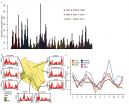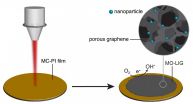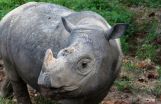(Press-News.org) Are humans unsustainable 'super predators'?
Want to see what science now calls the world's "super predator"? Look in the mirror.
Research published today in the journal Science by a team led by Dr. Chris Darimont, the Hakai-Raincoast professor of geography at the University of Victoria, reveals new insight behind widespread wildlife extinctions, shrinking fish sizes and disruptions to global food chains.
"These are extreme outcomes that non-human predators seldom impose," Darimont's team writes in the article titled "The Unique Ecology of Human Predators."
"Our wickedly efficient killing technology, global economic systems and resource management that prioritize short-term benefits to humanity have given rise to the human super predator," says Darimont, also science director for the Raincoast Conservation Foundation. "Our impacts are as extreme as our behaviour and the planet bears the burden of our predatory dominance."
The team's global analysis indicates that humans typically exploit adult fish populations at 14 times the rate of marine predators. Humans hunt and kill large land carnivores such as bears, wolves and lions at nine times the rate that these predatory animals kill each other in the wild.
Humanity also departs fundamentally from predation in nature by targeting adult quarry. "Whereas predators primarily target the juveniles or 'reproductive interest' of populations, humans draw down the 'reproductive capital' by exploiting adult prey," says co-author Dr. Tom Reimchen, biology professor at UVic. Reimchen originally formulated these ideas during long-term research on freshwater fish and their predators at a remote lake on Haida Gwaii, an archipelago on the northern coast of British Columbia.
The data set includes wildlife, tropical meat and fisheries systems from every continent and ocean, except Antarctica. The authors conclude with an urgent call to reconsider the concept of "sustainable exploitation" in wildlife and fisheries management. A truly sustainable model, they argue, would mean cultivating cultural, economic and institutional change that places limits on human activities to more closely follow the behaviour of natural predators. The full story in Science appears here: http://www.sciencemag.org/lookup/doi/10.1126/science.aac4249
INFORMATION:
Background:
"The Unique Ecology of Human Predators" project, supported by UVic, the Raincoast Conservation Foundation and the Hakai Institute includes 2,125 estimates of annual finite exploitation rates, drawing on data from more than 300 studies. Other co-authors include Caroline H. Fox and Heather M. Bryan of UVic, Raincoast and the Hakai Institute.
During four decades of fieldwork on Haida Gwaii, UVic biologist Dr. Tom Reimchen conceived the idea to look at how human predators differ from other predators in nature. Reimchen's predator-prey research revealed that predatory fish and diving birds overwhelmingly killed juvenile forms of freshwater fish. Collectively, 22 predator species took no more than two per cent of the adult fish. Nearby, Reimchen observed a stark contrast: fisheries exclusively targeted adult salmon, taking 50 per cent or more of the runs.
Media contacts:
Dr. Chris Darimont (Dept. of Geography) at 250-853-3287 or darimont@uvic.ca
Dr. Tom Reimchen (Dept. of Biology) at 250-721-7101 or reimchen@uvic.ca
Paul Marck (University Communications + Marketing) at 250-721-6246 or pcmarck@uvic.ca
Follow us on Twitter: @uvicnews
UVic media relations & services: http://www.uvic.ca/communicationsmarketing/media
Scientists have exposed a chink in the armour of disease-causing bugs, with a new discovery about a protein that controls bacterial defences.
Bacteria react to stressful situations - such as running out of nutrients, coming under attack from antibiotics or encountering a host body's immune system - with a range of defence mechanisms. These include constructing a resistant outer coat, growing defensive structures on their surface or producing enzymes that break down the DNA of an attacker.
The new research shows that a protein called sigma54 holds a bacterium's defences ...
WEST LAFAYETTE, Ind. -- Results of the XENON100 experiment are a bright spot in the search for dark matter.
The team of international scientists involved in the project demonstrated the sensitivity of their detector and recorded results that challenge several dark matter models and a longstanding claim of dark matter detection. Papers detailing the results will be published in upcoming issues of the journals Science and Physical Review Letters.
Dark matter is an abundant but unseen matter in the universe considered responsible for the gravitational force that keeps the ...
Scientists studying the 2009 A/H1N1 influenza pandemic have found that the inconsistent regional timing of pandemic waves in Mexico was the result of interactions between school breaks and regional variations in humidity.
The research published in PLOS Computational Biology, led by Dr. James Tamerius at the University of Iowa and Dr. Gerardo Chowell at Georgia State University, applied mathematical models to understand the social and environmental processes that generated two distinct pandemic outbreaks ("waves") in Mexico during the summer and fall of 2009.
The summer ...
Children who have been abused or exposed to other types of trauma typically experience more intense emotions than their peers, a byproduct of living in volatile, dangerous environments.
But what if those kids could regulate their emotions? Could that better help them cope with difficult situations? Would it impact how effective therapy might be for them?
A University of Washington-led team of researchers sought to address those questions by studying what happens in the brains of maltreated adolescents when they viewed emotional images, and then tried to control their ...
PRINCETON, N.J.--Tracking mobile phone data is often associated with privacy issues, but these vast datasets could be the key to understanding how infectious diseases are spread seasonally, according to a study published in the Proceedings of the National Academy of Sciences.
Princeton University and Harvard University researchers used anonymous mobile phone records for more than 15 million people to track the spread of rubella in Kenya and were able to quantitatively show for the first time that mobile phone data can predict seasonal disease patterns.
Harnessing ...
Glenview, Ill. (August 20, 2015)--The popularity of electronic cigarettes has steadily increased worldwide, but little is known about their effects on health. New research suggests that the single use of an electronic cigarette approximating the nicotine exposure of one tobacco cigarette reduces the sensitivity of the cough reflex.
The study tested 30 adult lifetime nonsmokers with no history of asthma or respiratory diseases and used cough tests to determine how e-cigarettes affect the cough reflex. Capsaicin, the pungent extract of red peppers, was used to induce a ...
Medicaid is expected to save billions of dollars a year as patents for several blockbuster antipsychotic medications expire and use of generic versions of these drugs increases, according to a new study by researchers at the University of Maryland School of Medicine. These savings may provide relief from the high costs of these medications and allow policymakers to lift restrictions on patients' access, the researchers argue.
The study forecast that annual Medicaid payments for antipsychotic medicines will decrease by nearly $1.8 billion (or nearly 50 percent) by 2016 ...
HOUSTON - (Aug. 20, 2015) - Rice University chemists who developed a unique form of graphene have found a way to embed metallic nanoparticles that turn the material into a useful catalyst for fuel cells and other applications.
Laser-induced graphene, created by the Rice lab of chemist James Tour last year, is a flexible film with a surface of porous graphene made by exposing a common plastic known as polyimide to a commercial laser-scribing beam. The researchers have now found a way to enhance the product with reactive metals.
The research appears this month in the ...
Leading scientists and experts in the field of rhino conservation state in a new paper that it is safe to consider the Sumatran rhinoceros extinct in the wild in Malaysia. The survival of the Sumatran rhino now depends on the 100 or fewer remaining individuals in the wild in Indonesia and the nine rhinos in captivity.
Despite intensive survey efforts, there have been no signs of the wild Sumatran rhinoceros (Dicerorhinus sumatrensis) in Malaysia since 2007, apart from two females that were captured for breeding purposes in 2011 and 2014. Scientists now consider the species ...
An international team of scientists headed by biologists at UC San Diego has discovered that an important class of stem cells known as human "induced pluripotent stem cells," or iPSCs, which are derived from an individual's own cells, can be differentiated into various types of functional cells with different fates of immune rejection.
The scientists also found that these cells may not be rejected by the immune system if iPSCs are turned into retinal pigment epithelium cells destined for the eye.
Their discovery provides hope for the development of human stem cell therapies ...




